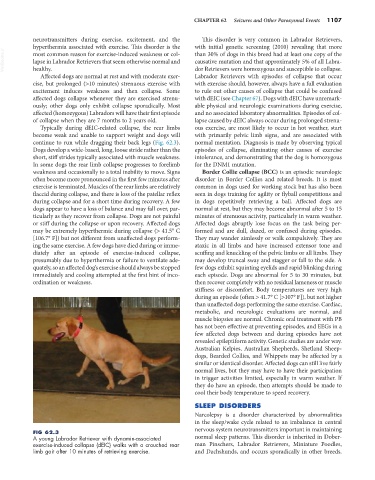Page 1135 - Small Animal Internal Medicine, 6th Edition
P. 1135
CHAPTER 62 Seizures and Other Paroxysmal Events 1107
neurotransmitters during exercise, excitement, and the This disorder is very common in Labrador Retrievers,
hyperthermia associated with exercise. This disorder is the with initial genetic screening (2010) revealing that more
VetBooks.ir most common reason for exercise-induced weakness or col- than 30% of dogs in this breed had at least one copy of the
causative mutation and that approximately 5% of all Labra-
lapse in Labrador Retrievers that seem otherwise normal and
healthy.
Labrador Retrievers with episodes of collapse that occur
Affected dogs are normal at rest and with moderate exer- dor Retrievers were homozygous and susceptible to collapse.
cise, but prolonged (>10 minutes) strenuous exercise with with exercise should, however, always have a full evaluation
excitement induces weakness and then collapse. Some to rule out other causes of collapse that could be confused
affected dogs collapse whenever they are exercised strenu- with dEIC (see Chapter 67). Dogs with dEIC have unremark-
ously; other dogs only exhibit collapse sporadically. Most able physical and neurologic examinations during exercise,
affected (homozygous) Labradors will have their first episode and no associated laboratory abnormalities. Episodes of col-
of collapse when they are 7 months to 2 years old. lapse caused by dEIC always occur during prolonged strenu-
Typically during dEIC-related collapse, the rear limbs ous exercise, are most likely to occur in hot weather, start
become weak and unable to support weight and dogs will with primarily pelvic limb signs, and are associated with
continue to run while dragging their back legs (Fig. 62.3). normal mentation. Diagnosis is made by observing typical
Dogs develop a wide-based, long, loose stride rather than the episodes of collapse, eliminating other causes of exercise
short, stiff strides typically associated with muscle weakness. intolerance, and demonstrating that the dog is homozygous
In some dogs the rear limb collapse progresses to forelimb for the DNM1 mutation.
weakness and occasionally to a total inability to move. Signs Border Collie collapse (BCC) is an episodic neurologic
often become more pronounced in the first few minutes after disorder in Border Collies and related breeds. It is most
exercise is terminated. Muscles of the rear limbs are relatively common in dogs used for working stock but has also been
flaccid during collapse, and there is loss of the patellar reflex seen in dogs training for agility or flyball competitions and
during collapse and for a short time during recovery. A few in dogs repetitively retrieving a ball. Affected dogs are
dogs appear to have a loss of balance and may fall over, par- normal at rest, but they may become abnormal after 5 to 15
ticularly as they recover from collapse. Dogs are not painful minutes of strenuous activity, particularly in warm weather.
or stiff during the collapse or upon recovery. Affected dogs Affected dogs abruptly lose focus on the task being per-
may be extremely hyperthermic during collapse (> 41.5° C formed and are dull, dazed, or confused during episodes.
[106.7° F]) but not different from unaffected dogs perform- They may wander aimlessly or walk compulsively. They are
ing the same exercise. A few dogs have died during or imme- ataxic in all limbs and have increased extensor tone and
diately after an episode of exercise-induced collapse, scuffing and knuckling of the pelvic limbs or all limbs. They
presumably due to hyperthermia or failure to ventilate ade- may develop truncal sway and stagger or fall to the side. A
quately, so an affected dog’s exercise should always be stopped few dogs exhibit squinting eyelids and rapid blinking during
immediately and cooling attempted at the first hint of inco- each episode. Dogs are abnormal for 5 to 30 minutes, but
ordination or weakness. then recover completely with no residual lameness or muscle
stiffness or discomfort. Body temperatures are very high
during an episode (often > 41.7° C [>107° F]), but not higher
than unaffected dogs performing the same exercise. Cardiac,
metabolic, and neurologic evaluations are normal, and
muscle biopsies are normal. Chronic oral treatment with PB
has not been effective at preventing episodes, and EEGs in a
few affected dogs between and during episodes have not
revealed epileptiform activity. Genetic studies are under way.
Australian Kelpies, Australian Shepherds, Shetland Sheep-
dogs, Bearded Collies, and Whippets may be affected by a
similar or identical disorder. Affected dogs can still live fairly
normal lives, but they may have to have their participation
in trigger activities limited, especially in warm weather. If
they do have an episode, then attempts should be made to
cool their body temperature to speed recovery.
SLEEP DISORDERS
Narcolepsy is a disorder characterized by abnormalities
in the sleep/wake cycle related to an imbalance in central
nervous system neurotransmitters important in maintaining
FIG 62.3
A young Labrador Retriever with dynamin-associated normal sleep patterns. This disorder is inherited in Dober-
exercise-induced collapse (dEIC) walks with a crouched rear man Pinschers, Labrador Retrievers, Miniature Poodles,
limb gait after 10 minutes of retrieving exercise. and Dachshunds, and occurs sporadically in other breeds.

